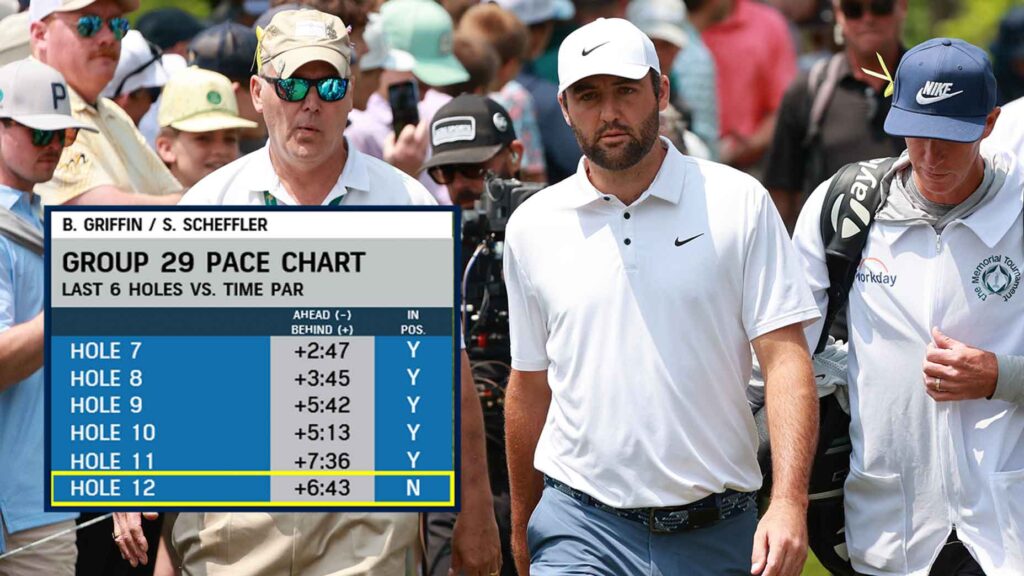Understanding Pace of Play in Professional Golf: A Deep Dive into the PGA Tour
Pace of play is a hotly debated yet frequently misunderstood topic in professional golf. It’s a conversation that surfaces during late Friday evenings when tournament leaders scramble to finish their rounds before darkness falls, or when the PGA Tour contemplates limiting field sizes in spring events to account for reduced daylight. The turmoil over pace of play often grows louder when viral videos emerge, showcasing players’ seemingly endless waggling rather than hitting the ball. But is the discourse surrounding these issues genuinely informed? The answer is complex, yet the PGA Tour is taking steps to improve transparency and understanding regarding this critical aspect of the game.
For the past two months, the PGA Tour has trialed the use of Distance Measuring Devices—commonly known as rangefinders—across both the PGA Tour and Korn Ferry Tour. Initial findings indicate that these devices have had a positive impact on pace of play. A significant 58% of players surveyed expressed that the use of rangefinders has simplified and expedited their game, particularly around the green. Data showcases a tangible difference as shots from 40-60 yards away were played approximately five seconds faster with these devices than without. This extension of technology into the game has the potential to enhance not just individual performance, but also the flow of the tournament as a whole.
In order to foster greater understanding around pace of play, the PGA Tour plans to share more specific data related to group and hole performance. Viewers will soon have access to comprehensive pace of play information via various digital platforms, including the Tour’s official website and broadcasts by CBS, NBC, and ESPN. Every round played will be monitored by the Tour’s rules management app, which timestamps each player’s first shot until the last player holes out. This meticulous tracking offers insight into how long a group takes on each hole, allowing fans to better grasp the overarching narrative of pace—essentially elevating the viewer experience.
As an example of how this new tracking will manifest, statistics from tournament rounds will be displayed prominently, including average times taken by groups on each hole. For instance, during an opening round, groups may collectively complete the first hole in approximately 12 minutes and 31 seconds—a metric that can easily be compared against the PGA Tour’s designated “Time Par.” According to the Tour, expected times for completing par-3 and par-4 holes during threesomes are 11 and 14 minutes, respectively. Meeting or exceeding these time expectations is significant, contributing to a more fluid tournament atmosphere that benefits both players and fans alike.
However, the concept of being "out of position" is critical to how pace of play is monitored. If players fall behind the established Time Par, they may trigger action from the PGA Tour’s rules staff. Fans can anticipate increased clarification on this subject during broadcasts, including when and why certain groups find themselves on the clock. For instance, during the Memorial Tournament, players Scottie Scheffler and Ben Griffin were put on the clock due to slow play after missing their Time Par by nearly 32 minutes over six consecutive holes. Such incidents will now be reported for viewers, enhancing transparency and accountability in pace of play monitoring.
In addition to hole completion statistics, the Tour plans to share insights related to the influence of varying course conditions on playtime. Factors such as weather conditions and hole placements on the green significantly affect the time it takes players to complete shots. For example, a long par-3 may take considerably less time when the hole is cut in a favorable location compared to a more challenging spot. This nuanced understanding will assist viewers in appreciating the intricacies involved in professional golf and how they affect pace.
While efforts to improve transparency are commendable, it’s worth noting that the PGA Tour has primarily chosen to keep individual player averages out of the public eye. This situation often fuels conversations about which specific players are quick or slow pace-of-play outliers. For the time being, the focus will remain on groups and holes rather than pinpointing individuals, as individual performance can fluctuate based on multiple variables, including the day’s playing conditions and a player’s unique rhythm.
This strategic decision to prioritize group pace over individual data is multifaceted. Keeping the focus broad helps mitigate the distortion that can arise from singular player analysis, where a player may appear faster during a successful round while another may be unfairly labeled as sluggish during a mediocre performance. By concentrating on group metrics, the PGA Tour aims to foster a collective responsibility for pace among players, thereby promoting a more conducive atmosphere for all involved.
As fans eagerly await the rollout of comprehensive pace-of-play data during upcoming broadcasts, it’s crucial to recognize the significance of this development. The introduction of statistics and insights regarding how various groups perform against established Time Pars will not only enrich the viewing experience but also encourage discussions around strategy, skill, and the importance of maintaining a good pace. This approach signifies a positive shift in how the PGA Tour engages its audience, fostering a deeper understanding of the sport and its inner workings.
In conclusion, as the PGA Tour releases more detailed pace of play information, fans and participants alike stand to benefit from a more informed understanding of this often-overlooked aspect of the game. With the integration of technology, the insight provided by Distance Measuring Devices, and a commitment to transparency, the narrative surrounding pace of play will continue to evolve. This evolution is crucial, not just for enhancing the spectator experience, but also for supporting the sport’s athletes in finding a rhythm that suits both their personal styles and the competitive nature of professional golf. The future of pace of play looks promising, paving the way for a more engaging and coherent golfing experience.


